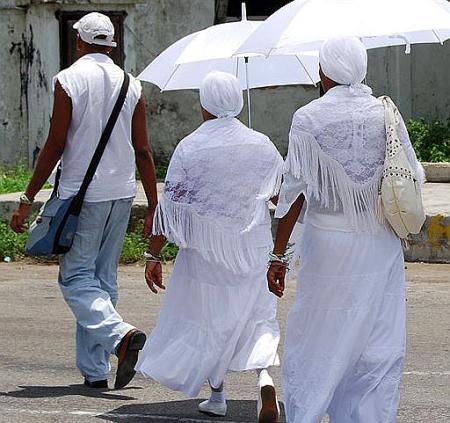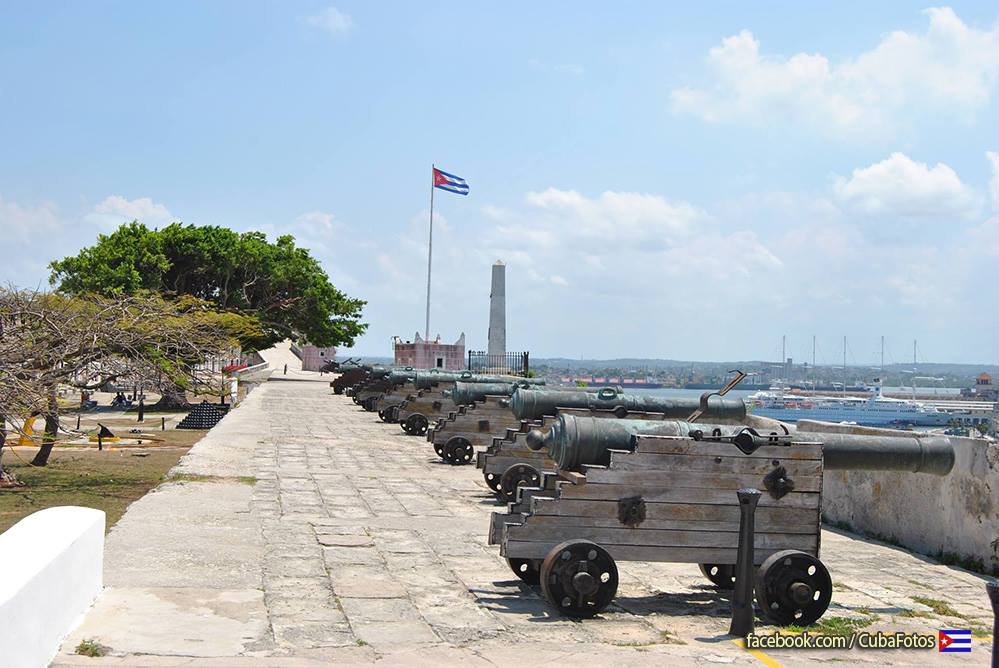SANTERIA. HIGHER AUTHORITY.
Between 1800 and 1865 occurs the more substantial entry of slaves to Cuba. This brings as consequence that these people, which snatched their customs, culture and ideologies are virtually forced to rescue their traditions in any way. This form is none other than the religious syncretism.
Slaves were forbidden to practise their religion and forced them to revere Catholic Saints, so they start naming Saints such as their own idols, for example Santa Barbara is also known as Chango and the Virgen de la Caridad is called Ochun. While Cuban society is officially atheist, a large part of the population practice the Santería or Regla de Ocha.
It is a polytheistic religion, according to which each person is born under the protection of a Saint or orisha that must reverence of life through some sacrifices. These sacrifices are based on offering some kind of foods corresponding to the orisha, playing the instrument that this “pleased”, and even dance to their Saint.
The priests of this religion are known such as santeros and santeras, and occupy the high authority the babalawos, which are those priests who after conducting specialized studies and hold a series of rituals to reach this position of preference.
https://youtu.be/nQqQAO8Qs6c
The greater sacrifice that comes to a practitioner or believer is devoted to the Holy by the corresponding rituals for considering that he has received all the blessing of this as the force of spirituality which translates into protection and yoruba deity or entity which constitutes the process of religious consecration which means the Holy to carry the person’s head.
This consecration means that the person will receive a baptism, and therefore an opinion called Ita, where the Holy makes you get advice and guidance so that the person knows to lead by his earthly life…
Most popular Orisha:
Eleggua: Is known for being the guardian of the roads. He is invoked first before any ritual. It is recognized by punishing those who do not revere him and attributed the numbers 3 and 21, as well as the black and red colors.
Obatala: the creator of the world and father of all the orishas and God of peace is considered. Their numbers are 8 and 16 and the color white is credited with.
Yemaya: It is the Queen of the seas and protector of mothers. It is prudent and wise. Their number is 7 and its colors Blue and white. Is syncretized with the Virgen de Regla.
Oshun: It is the Queen of rivers, lakes and gold. He is known to be very sensual and sweet. Their colors are yellow and gold and their number 5. Is syncretized with the Virgen de la Caridad
Chango: God of virility and strength, represents sexuality. Their numbers are 4 and 6 and its colors red and white. Is syncretized with Saint Barbara.
Oggun: God of iron and minerals, like the war it is not welcome among the other Saints. It is symbolized by the machetes, hammers and other instruments made of iron and metal. Its colors are black and green and their number is 7.
Babalu Aye: God of diseases, protection of patients and animals. It has the power to see the future. Their colors are purple and Brown (brown color in Cuba), his number 17. Is syncretized with Saint Lazarus.
Oya: Goddess of the sparks and hurricane force winds is responsible for receiving the dead at the entrance of the cemetery. Their number is 9, the brown color and is syncretized with the Virgin of Candelaria and Santa Teresita.
Agencies/PlumaTocororo/InternetPhotos/Excerpts/TheCubanHistory.com
THE CUBAN HISTORY, HOLLYWOOD.
Arnoldo Varona, Editor.
SANTERIA. AUTORIDAD SUPERIOR.
Entre los años 1800 y 1865 se produce la entrada más cuantiosa de esclavos a Cuba. Esto trae como consecuencia que estas personas, a las cuales se les arrebatan sus costumbres, cultura e ideologías se ven prácticamente obligadas a rescatar de alguna forma sus tradiciones. Esta forma no es otra que el sincretismo religioso.
A los esclavos les estaba prohibido practicar su religión y se les obligaba a reverenciar a los santos católicos, por lo que estos comienzan a nombrar a dichos santos como a sus propios ídolos, por ejemplo Santa Bárbara es también conocida como Changó y la Virgen de la Caridad es llamada Ochún. A pesar de que la sociedad cubana es oficialmente atea, una gran parte de la población practica la Santería o Regla de Ocha.
Es una religión politeísta, según la cual cada persona nace bajo la protección de un santo u orisha al que debe reverenciar de por vida mediante algunos sacrificios. Estos sacrificios se basan en la ofrenda de algún tipo de comida correspondiente al orisha, tocar el instrumento que a éste le “complace”, e incluso bailar para su santo.
Los sacerdotes de esta religión son conocidos como santeros o santeras, y la autoridad superior la ocupan los babalaos, que son aquellos sacerdotes que tras realizar estudios especializados y celebrar una serie de rituales alcanzan este puesto de preferencia.
El sacrificio mayor que llega a realizar un practicante o creyente es consagrarse al santo mediante los rituales correspondientes para considerar que ha recibido toda la bendición de éste como la fuerza de espiritualidad que se traduce en protección y poder de la entidad o deidad yoruba que constituye el proceso de consagración religiosa lo cual significa llevar el santo a la cabeza de la persona.
https://youtu.be/nQqQAO8Qs6c
Dicha consagración significa que la persona recibirá un bautismo y por lo tanto un dictamen denominado Itá, donde el santo le hace llegar los consejos y orientaciones para que la persona sepa conducirse por su vida terrenal..
Orishas más populares:
Elegguá: Se le conoce por ser el guardián de los caminos. Se le invoca primero antes de iniciarse cualquier ritual. Se le reconoce por castigar a aquellos que no le reverencian y se le atribuyen los números 3 y 21, así como los colores negro y rojo.
Obatalá: Se considera el creador del mundo y padre de todos los orishas así como dios de la paz. Sus números son el 8 y el 16 y se le atribuye el color blanco.
Yemayá: Es la reina de los mares y protectora de las madres. Es prudente y sabia. Su número es el 7 y sus colores el azul y el blanco. Se sincretiza con la Virgen de Regla.
Oshún: Es la reina de los ríos, los lagos y el oro. Se le conoce por ser muy sensual y dulce. Sus colores son el amarillo y el dorado y su número el 5. Se sincretiza con la Virgen de la Caridad
Changó: Dios de la virilidad y la fuerza, representa la sexualidad. Sus números son el 4 y el 6 y sus colores el rojo y el blanco. Se sincretiza con Santa Bárbara.
Oggún: Dios del hierro y los minerales, le gusta la guerra por lo que no es bienvenido entre los demás santos. Está simbolizado por los machetes, martillos u otros instrumentos hechos de hierro y metal. Sus colores son el negro y el verde y su número es el 7.
Babalú Ayé: Dios de las enfermedades, protector de los enfermos y los animales. Tiene el poder de ver el futuro.Sus colores son el violeta y el carmelita (color marrón en Cuba), su número el 17. Se sincretiza con San Lázaro.
Oyá: Diosa de las centellas y los vientos huracanados es la encargada de recibir a los muertos en la entrada del cementerio. Su número es el 9, su color el carmelita y se sincretiza con la Virgen de la Candelaria, y con Santa Teresita.
Agencies/PlumaTocororo/InternetPhotos/Excerpts/TheCubanHistory.com
THE CUBAN HISTORY, HOLLYWOOD.
Arnoldo Varona, Editor.












